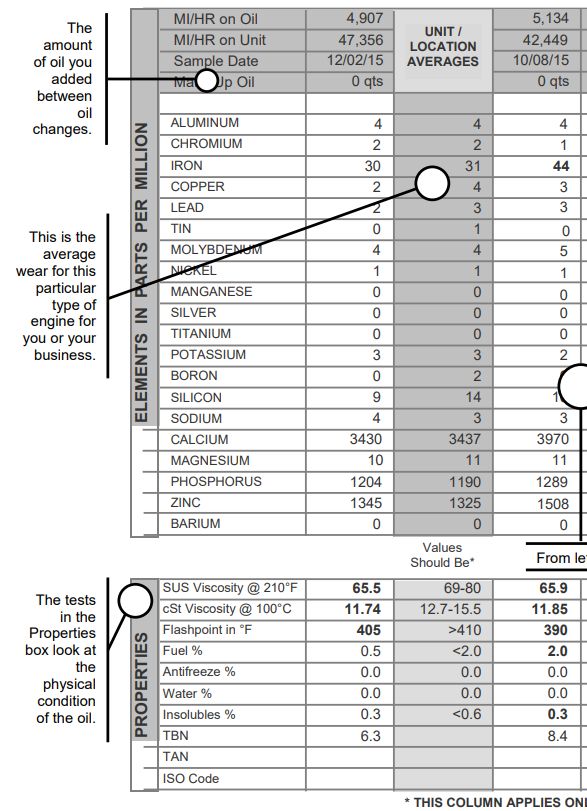Penulis lihat ada yang merekomendasi oli berdasarkan VoA, atau hasil uji oli yang langsung diambil dari bungkusnya:

Penulis tidak setuju dengan cara rekomendasi oli seperti ini. Ada banyak sifat oli yang penting yang tidak tercantum pada hasil uji oli. Seperti misalnya bahan dasar oli atau base oil.
Dari lembaga uji oli blackstone menyebutkan mereka tidak menguji itu, mereka cuma bisa membandingkan kandungan aditif.
Blackstone Laboratories – FAQS
Can you test the oil to see if it’s really synthetic?
No. We do not test the base stock of the oil. But what we can do is compare your used oil with what it should be to see if the additives match.
Dan tentunya yang senada, yaitu kandungan ester atau kandungan VI improver juga tidak dites. Padahal kandungan ini sangat penting untuk performa oli. VoA juga tidak menguji film strength atau bahkan uji aditif anti wear / EP. Kandungan Spash juga tidak disebut.
Oleh karena itu data kandungan oli yang dibagikan oleh Cauthelia Nandya merupakan daftar yang sangat berharga (walau disebut sudah kadaluarsa).
Daftar oli mesin PCMO, HDEO dan MCO yang cocok atau tidak cocok untuk kopling basah beserta informasi base oilnya
Beberapa analisa juga sumbernya dari perkiraan.
since we don’t test for glycol directly, we use potassium and sodium to look for coolant.
Jadi menurut penulis kita tidak bisa mendasarkan pemilihan oli dari hasil VoA. Karena yang penting penting justru nggak kesebut.
Spesifikasi oli juga sama saja:

Uniknya, orangnya lembaga uji oli Blackstone nggak maniak oli sintetik:
Come on, you’re holding out on me. I should use synthetic, right?
Buddy, you should use whatever you want. Synthetic oil won’t guarantee a longer engine life any more than my eating organic food will guarantee I’ll live until I’m 90. We here at Blackstone generally use regular petroleum-based oil because honestly, it works just as well for us.
Berikut cara baca hasil analisa.

Gas/Diesel Engine Report Explanation
Averages: Both the universal and unit averages are running averages and change with the
number of samples we analyze.Elements: Elements are quantified in the oil at parts per million levels (PPM). This list shows the most common sources of the elements in gasoline or diesel engine oil. Following each element is a description of where it comes from. They are grouped by category.
Wear Metals
Aluminum: Pistons, bearings, cases (heads & blocks). Clutch assembly and transmission
components in motorcycles
Chromium: Rings, a trace element in steel
Iron: Cylinders, rotating shafts, the valve train, and any steel part sharing the oil. Transmission shafts/gears and bearings in motorcycles
Copper: Brass or bronze parts, copper bushings, bearings, oil coolers
Lead: Bearings, leaded gas, fuel additives
Tin: Bearings, bronze parts, piston coating (rare)
Nickel: Trace element in steel, platings on some cylinder types
Silver: Bearings
Titanium: Some intake valves and connecting rods, aftermarket parts, oil additiveContaminants
Potassium: Antifreeze, additive in some oil types
Sodium: Antifreeze (ethylene glycol), additive in some gasoline engine oils. Sea water in marine engines
Silicon: Airborne dirt escaping air filtration, sealers, gaskets, sand-casted parts, and spray lubricants, antifreeze inhibitor, oil additiveAdditives
Molybdenum: Anti-wear additive, some types of rings
Manganese: Trace element, additive in some gasoline
Boron: Detergent/dispersant additive, antifreeze inhibitors
Calcium: Detergent/dispersant additive
Magnesium: Detergent/dispersant additive
Phosphorus: Anti-wear additive
Zinc: Anti-wear additive
Barium: Detergent/dispersant additive used in some syntheticsPhysical properties
Viscosity/Flashpoint: If fuel is present in the oil, the Viscosity and Flashpoint will often be lower than stated in the “Values Should Be” line. A high viscosity may show oil oxidation or high levels of soot. It can also show an oil additive in use.
Fuel %: Indicates the amount of volatile fuel dilution found in the oil.
Antifreeze %: Indicates the amount of antifreeze found in the oil. A question mark means we found possible traces of coolant, but not enough to definitively say it’s there.
Water %: Indicates the amount of water found in the oil.
Insolubles %: Insolubles are solid materials present in the oil. They are typically free carbon from the oxidation of the oil itself, along with blow-by past the rings.
TBN disebut dipengaruhi kandungan Kalsium atau magnesium.
The TBN is based on the level of calcium sulfinate and magnesium sulfinate in the oil, and transmission oil doesn’t have much of it.
Kesimpulannya apa?
maklum lagi gak punya banyak waktu buat baca & memahami
😆
SukaSuka
Intinya VoA atau spek itu nggak bisa jadi patokan pilih oli karena justru nggak ditunjukkan yang penting 🙂
SukaSuka